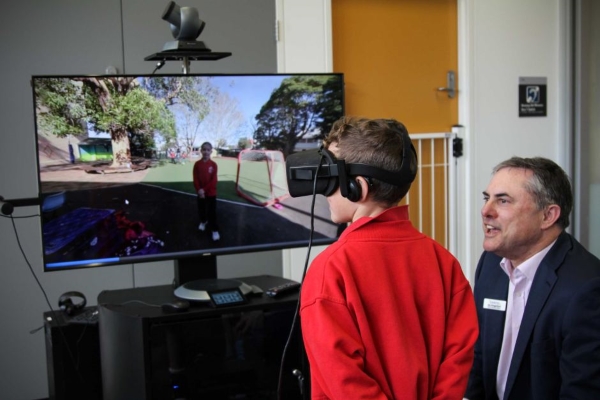[This story from ABC News in Australia describes one of several efforts to use presence to provide patients and their family, friends and caregivers the experience of various health conditions. The original story includes four more pictures and the 1:50 minute 360 degree video (also available on YouTube). –Matthew]

[Image: The VR experience was filmed at a Sydney school with students from Tyler’s class. Credit: ABC Radio Sydney: Harriet Tatham]
Virtual reality experience replicates life as a child with hearing loss
By Harriet Tatham
September 24, 2018
For anybody with hearing loss, articulating the isolation it causes is almost impossible.
For a child, it’s even harder.
But a new virtual reality (VR) experience, designed to immerse users in a playground and classroom as a child with hearing loss, is helping to foster empathy in parents, teachers and other students.
“They didn’t think I could hear so little,” eight-year-old Tyler Potaka said of his peers.
Tyler has bilateral mild to moderate hearing loss, meaning he has hearing loss in both ears.
For his mother Philippa, the experience wasn’t quite so matter-of-fact.
“It was very emotional to put your mind and your head and your body and transplant into your own child and to experience what they see and hear, or don’t hear.
“You really are able to have more empathy, you’re able to sympathise with not being able to hear.”
Isolated and vulnerable
The VR project was launched by Sydney charity The Shepherd Centre and filmed at a Newtown primary school.
“We decided we should do it from the perspective of a child … in the classroom and in the playground and do a comparison as to what it would be like with [hearing aids] and without.”
Nick Hunter, the creative director from innovation company Paper Moose which led the design, said the VR team worked with audiology specialists to accurately recreate how hearing loss sounds.
“You start in the playground and the audio is quite muffled,” he said.
“I was really surprised when we were talking to the specialists and we did our first pass at what we thought would be moderate hearing loss, and the expert said, ‘No, you need to go further — it’s much more degraded than that.”
After experiencing the muffled audio in the playground, the user is moved to the classroom where the teacher asks you a question but you’re unable to understand.
“When the whole experience was finished, and we sat down and watched it in its entirety, I found it surprisingly emotional at how isolated and vulnerable I felt,” Mr Hunter said.
Early intervention important
Dr Anne Fulcher, principal listening and spoken word specialist at the Shepherd Centre, said she believed the technology was so powerful that it could lead to better clinical outcomes.
“It’s wonderful to help new parents to see the impact of hearing loss and why it’s so important to help them with amplification and early intervention as soon as possible,” Dr Fulcher said.
And the benefit came from empathy, which would encourage parents and carers to intervene earlier, she said.
“A lot of the families say they don’t want their children to wear devices because it makes them look different and the kids will bully them.
“Often our reply is, ‘Well, if they don’t have hearing aids, that’s setting them up for being bullied because they will sound different, they will act different, they won’t be a part of the groups because it will be too difficult, their speech and language will be delayed; so it’s setting them up for all types of social and long-term poor outcomes’.”
While the technology is offered at The Shepherd Centre, Dr Fulcher said the team would work towards sharing it with schools and government bodies.